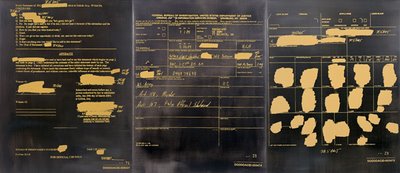Jenny Holzer

Some of the most striking art to be inspired by the “War on Terror” is New Yorker (and RISD grad) Jenny Holzer’s series of screenprinted paintings reproducing U.S. government records recounting what some might call war crimes.
A small show at Montserrat College of Art in Beverly presents three of these artworks. One reproduces a 2003 U.S. government autopsy report on the strangulation of a 52 year old Iraqi “detainee” that determines his death to be a homicide. Another is a report from an FBI interrogator at Guantanamo Bay suggesting that he/she may have witnessed the aftermath of a prisoner beating.
But the standout piece here is 11 pages of government reports about a handcuffed Iraqi cow herder shot in the side of the head by an American soldier.

None of the works in Holzer's series is particularly impressive visually – though there is something vivid about the poor photocopies, the blacked-out sections. These are conceptual works, their power deriving from the incidents described and from the authority of the accounts – the government’s own records. Holzer’s format forces you to stop and read these straight-from-the-horse’s-mouth reports. Perhaps you have heard them referenced in news stories, but most likely haven’t seen them directly before. At the same time these matter-of-fact documents are themselves portraits of the vast bureaucracy that is the U.S. military – a bureaucracy that cocoons the essential violence of the enterprise in normalizing layers of rules and paperwork.
Holzer’s series focuses almost exclusively on where things have gone wrong – from prisoner abuse, which seems more and more to have been the expressed policy of the Bush Administration, to battlefield atrocities, which we still like to categorize as aberrations. The story of the shooting of the bound cow herder brings to mind something a wise friend told me early in our current wars: war always includes atrocity. We like to think that we can have a clean and just war, with smart bombs and smart tactics. There are many many fine upstanding soldiers, but inevitably war is messy, and not everyone is upstanding, and inevitably atrocities occur. So, my friend argued, those arguing for war must take responsibility for the atrocities that certainly will come with it too.
In this case, Holzer reveals the sorry story of the shooting page by grainy photocopied page. The soldiers were outside Taal Al Jal during an American raid on the town. At some point they were ordered to stop all men leaving the village. So some of them seized a herder in a nearby field. One soldier bound the man’s hands behind his back with flexi-cuffs while a second soldier aimed his gun at the man.
The second soldier told investigators on March 1, 2004, that he watched the Iraqi man through the sight of his gun (probably a rifle), thought he saw a “lunge” toward the other soldier, so shot him. He’s vague about whether he knew that the man’s hands were bound and what this “lunge” was.
Later that month, the shooter claims that adrenaline caused him to make a fatal mistake. You can’t tell if he’s just trying to escape responsibility, or if he’s genuinely remorseful. “Looking back on it now, I don’t think the Iraqi lunged,” he says. “…I would have never shot that man had I been thinking clearly.”
Jenny Holzer, Montserrat College of Art, 23 Essex St., Beverly, Massachusetts, May 4 to 27, 2009.
Previously:
Jennny Holzer’s exhibit “Archive” at Barbara Krakow Gallery in 2007.
Pictured: Jenny Holzer, a detail of “Herder black,” 2006, then the whole thing. Oil on linen in eleven panels, ©Jenny Holzer, courtesy Artist Rights Society, Barbara Krakow Gallery, Boston and Cheim & Read, New York.






0 Comments:
Post a Comment
<< Home